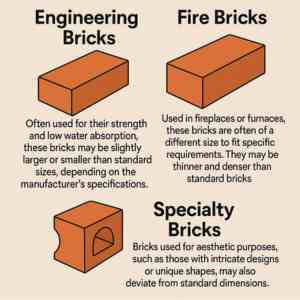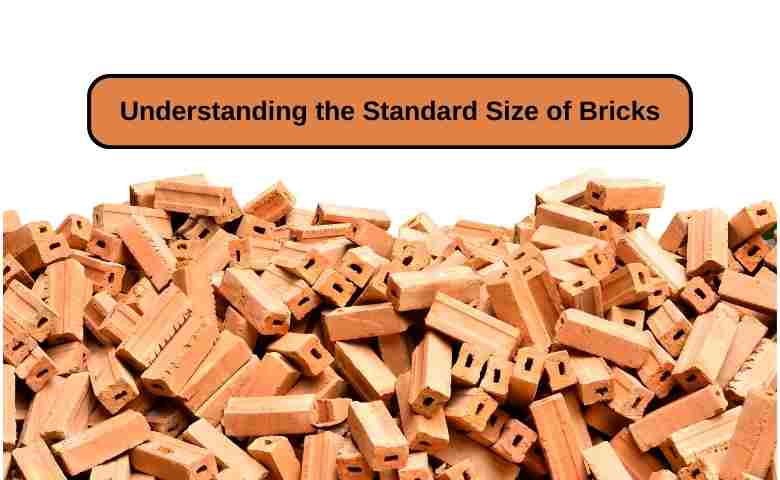Last Updated on March 28, 2025 by Admin
When embarking on any construction project, understanding the standard size of bricks is crucial. Bricks are one of the most commonly used building materials worldwide, and their dimensions significantly influence structures’ design, stability, and aesthetics. This guide will explore the standard size of bricks, including their width, length, and overall dimensions, while addressing the variations and considerations necessary for global applications. Whether you’re a seasoned builder, a DIY enthusiast, or someone interested in architecture, this post will provide you with essential knowledge about brick dimensions.
Table of Contents
What is the Standard Size of Bricks?
The standard size of bricks can vary depending on the country, region, and specific use case. However, a widely recognized standard exists, especially for clay bricks used in general construction.
- Brick Length: Typically, the standard brick length is 190 mm (7.48 inches).
- Brick Width: The standard brick width is around 90 mm (3.54 inches).
- Brick Height: The standard height is 90 mm (3.54 inches).

These dimensions are for modular bricks, most commonly used in modern construction. The sizes might differ slightly in different countries or for non-modular bricks, but the above measurements provide a general benchmark.
Practice 15+ AI-generated technical and HR interview questions for Civil, BIM, QS, Planning, HSE and Construction roles. Get instant feedback, improved answers, a 7-day improvement plan, and a full PDF report. Designed exclusively for construction professionals.
One free full interview session included. No credit card required.
Understanding Brick Size Standards Across the World
While the dimensions mentioned above are standard, bricks come in various sizes depending on regional practices and building codes. Let’s look at some examples:
United Kingdom
In the UK, the standard brick size is 215 x 102.5 x 65 mm. These dimensions are slightly larger compared to other regions, which influences the thickness of mortar joints and overall wall thickness.
United States
In the US, the standard size of bricks is typically 194 x 92 x 57 mm, known as the modular size. However, you may also find the “standard” size, which is 203 x 92 x 57 mm.
Australia
Australian bricks are usually sized at 230 x 110 x 76 mm, reflecting a balance between traditional British and modern modular sizes.
Each country might have slight variations in brick sizes due to historical construction practices and material availability, but these dimensions are generally within a close range of each other.
Why the Standard Dimension of Bricks Matters
Understanding the standard dimension of bricks is essential for several reasons:
- Structural Integrity: The size of a brick directly impacts the stability of the construction. Uniform brick sizes ensure that walls and other structures are built symmetrically, maintaining the load-bearing capacity of the structure.
- Aesthetics: Bricks of a consistent size contribute to the visual appeal of a building. Mismatched or irregular brick sizes can result in uneven surfaces and unsightly mortar lines.
- Cost Efficiency: Using standard-sized bricks allows for more efficient use of materials. Builders can estimate the number of bricks required for a project more accurately, reducing waste and controlling costs.
- Construction Speed: Standard sizes simplify the construction process. Builders are familiar with these sizes, and tools are often designed to accommodate them, speeding up the construction process.
Brick Sizes: Standard vs. Non-Standard
While the standard dimensions mentioned are most common, there are also non-standard brick sizes used for specific applications:
Engineering Bricks
Often used for their strength and low water absorption, these bricks may be slightly larger or smaller than standard sizes, depending on the manufacturer’s specifications.
Fire Bricks
Used in fireplaces or furnaces, these bricks are often of a different size to fit specific requirements. They may be thinner and denser than standard bricks.
Specialty Bricks
Bricks used for aesthetic purposes, such as those with intricate designs or unique shapes, may also deviate from standard dimensions.

Factors Influencing the Dimension of Brick
Several factors influence the dimension of bricks, including:
- Manufacturing Process: Bricks are made by pressing clay into molds, and the final size can be affected by the shrinkage of the clay as it dries and is fired.
- Regional Standards: Local building codes and traditions often dictate the preferred size of bricks in a region. For example, the UK has different size standards than the US or Australia.
- Usage: The intended use of the brick can influence its size. Structural bricks, facing bricks, and paving bricks might all have different dimensions based on their application.
- Architectural Design: Some architectural styles or specific projects may require bricks of non-standard sizes to achieve a particular aesthetic or structural outcome.
How to Choose the Right Brick Size for Your Project
Selecting the correct brick size for your project depends on several factors:
- Project Type: For general construction, standard bricks are typically the best choice. However, for specialized projects like fireplaces or decorative walls, non-standard bricks might be required.
- Local Availability: It’s essential to choose a brick size that is readily available in your area to avoid delays and additional costs.
- Aesthetic Preferences: If the appearance of the brickwork is crucial, consider the brick size about the overall design. Smaller bricks can offer more detailed patterns, while larger bricks can create a more solid, uniform look.
- Structural Needs: The load-bearing requirements of your project might dictate the size of the bricks used. Engineering bricks, for example, might be required for certain structural elements.
Impact of Brick Dimension on Construction Techniques
The dimension of a brick plays a significant role in determining the construction techniques used in a project. For example:
Mortar Joints
The size of the brick influences the thickness of the mortar joints. Standard bricks typically require mortar joints of about 10 mm, which affects the overall height and length of walls.
Bonding Patterns
Different brick sizes allow for various bonding patterns, such as the stretcher bond, English bond, or Flemish bond. The choice of pattern can impact both the structural integrity and the aesthetic appeal of the wall.
Load Distribution
The uniformity in brick size ensures that the load is evenly distributed across the structure, reducing the risk of cracks and structural failure.
Common Mistakes When Choosing Brick Sizes
Even experienced builders can make mistakes when selecting brick sizes. Some common pitfalls include:
- Ignoring Local Standards: Using bricks that do not conform to local size standards can lead to complications with building codes and regulations.
- Overlooking Aesthetic Considerations: Focusing solely on structural requirements without considering how the brick size will affect the appearance of the finished structure.
- Failing to Account for Mortar: Not considering the mortar joints can lead to miscalculations in wall dimensions and the overall layout.
The Importance of Standard Brick Dimensions in Global Construction
Understanding the standard size of bricks is a fundamental aspect of construction that influences both the structural integrity and aesthetics of a building. While there is some variation in brick sizes globally, the dimensions typically fall within a close range, making it easier for builders to adapt to different regional standards. Whether you are constructing a small garden wall or a large commercial building, choosing the right brick size is crucial for the success of your project.
As the construction industry continues to evolve, staying informed about standard brick dimensions and their impact on building practices is essential. By considering factors such as project type, local availability, and structural requirements, you can ensure that your next construction project is both efficient and aesthetically pleasing.
Related Posts:
- Construction Building: Everything you should know about
- Glazed Brick Slips: Colour Trends and Ideas
- 100 Essential Concepts in Civil Engineering: Understanding Key Principles and Techniques
- Mechanical Engineering Salary Insights
- 51 top AutoCAD Interview Questions and Answers [2025 Updated]
- Various Types Construction Materials Used In Building Constructions


